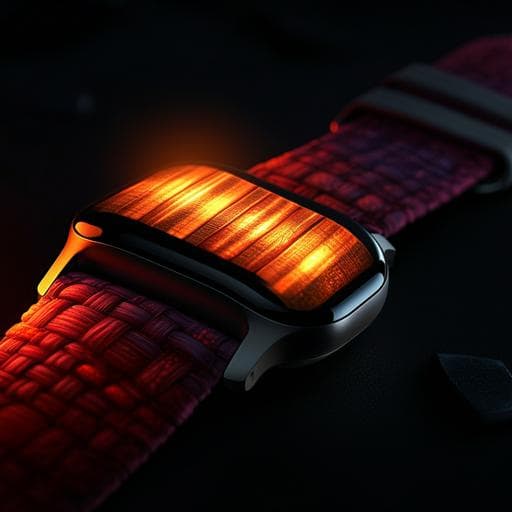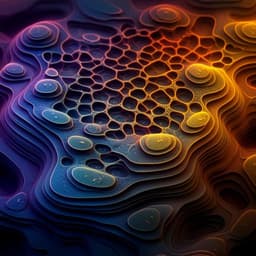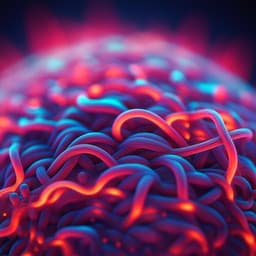
Engineering and Technology
Highly efficient fiber-shaped organic solar cells toward wearable flexible electronics
D. Lv, Q. Jiang, et al.
Discover the exciting advancements in fiber-shaped organic solar cells (FOSCs) that have surpassed 9% efficiency, thanks to the innovative work by Dan Lv, Qianqing Jiang, Yuanyuan Shang, and Dianyi Liu. These eco-friendly solar cells are tailor-made for wearable electronics, proving their capability by powering devices and even charging smartwatches woven into textiles.
~3 min • Beginner • English
Introduction
The study addresses the long-standing efficiency bottleneck of fiber-shaped organic solar cells (FOSCs), which have remained around 2% for a decade, unlike fiber-shaped dye-sensitized and perovskite solar cells that exceed 10%. FOSCs are attractive for wearable electronics due to their 1D geometry, weave-ability, all-solid-state operation, and environmentally friendly processing. The research aims to improve FOSC efficiency by leveraging advances in non-fullerene acceptors (NFAs), whose broader absorption (extending beyond 1000 nm) has enabled >18% efficiencies in planar organic photovoltaics. The central hypothesis is that integrating NFA-based active layers into FOSCs, combined with optimized interlayers, electrodes, and processing controls (notably humidity), will overcome efficiency limitations and enable practical wearable power textiles.
Literature Review
Previous FOSCs predominantly used polymer donors with fullerene acceptors (e.g., P3HT:PC61BM, PTB7:PC71BM), whose limited visible-range absorption constrained efficiencies to below ~10% in planar devices and ~2% in fibers. In contrast, NFA materials rapidly advanced planar OPVs to >18% efficiencies due to extended absorption and improved energetics. Fiber-shaped DSSCs and perovskite solar cells have achieved >10% through material and structural optimizations, demonstrating the viability of fiber architectures for meaningful power outputs. Organic photovoltaic textiles have been demonstrated with FOSCs, underscoring their application potential. Despite this, NFA-based photoactive layers had not been introduced to FSCs prior to this work, and the impact of ambient humidity on fiber-device film formation and performance remained underexplored.
Methodology
Device architecture employed industrial-grade stainless-steel wire (∼100 µm diameter) as substrate/core electrode. Layers were sequentially deposited using a programmable slide-coating system to enhance reproducibility and scalability. The electron transport layer (ETL) was PDINO (methanol solution, typical optimal concentration 40 mg/mL), followed by a ternary active layer PM6:Y6:PC71BM (weight ratio 1:1:0.2) dissolved in chloroform with 0.5 vol% 1-chloronaphthalene, and then PEDOT:PSS interlayers: a thin AL4083 layer and a thicker PH1000 layer (multiple coating cycles to ∼250 nm) serving as hole transport layer and transparent conductive layer to improve contact with the counter electrode. Counter electrodes were either carbon nanotube (CNT) yarn tightly twined around the primary electrode or 25 µm Ag wire. Coating speeds for PDINO were 5000 mm/min; for PEDOT:PSS layers 1000 mm/min; annealing at 140 °C for 4 min in air. Encapsulation, when used, was performed by coating a general-purpose instant adhesive (Kafuter-502) three times at 1000 mm/min and drying about 3 min. Layer optimization included varying PDINO concentration (20–50 mg/mL), active layer solution concentration (e.g., 16–24 mg/mL), PH1000 thickness via coating cycles, AL4083 insertion, and counter-electrode pitch (e.g., ∼0.7 mm). Alternative ETLs (ZnO nanoparticles and ZnO nanocrystals) and binary PM6:Y6 active layers were also evaluated. Characterization: Morphology assessed by SEM (Zeiss Gemini500) and cross-sections prepared via Helium Ion Microscope–Focused Ion Beam (Zeiss ORION NanoFab) with Pt protection layer. Photovoltaic performance measured under AM 1.5 G (100 mW/cm²) using a 450 W calibrated solar simulator (Newport SP94043A-SR1) with a Keithley 2400; scan rate 50 mV/s, dwell 30 ms. The illuminated area was set by a mask as irradiation length × wire diameter; diffuse-reflection tests used printer paper. EQE measured in air (Newport Quantx-300); integrated Jsc compared to J–V. Electrical analyses included dark J–V ideality factor extraction, EIS at Voc (Cole–Cole plots, recombination resistance), and SCLC measurements on electron-only and hole-only fiber devices to estimate trap density and mobilities. Humidity studies: All fabrication and testing were in ambient air; relative humidity (RH) and temperature were recorded. Devices were fabricated across RH ranges (~10–15% up to ~69%) to correlate performance with humidity. Active layer films were formed under controlled RH (40–69%) and visualized by SEM to observe humidity-induced morphological defects (holes). Water was intentionally added to the precursor (5% and 20% v/v) to verify causation of holes. Solvent effects were probed by substituting chlorobenzene (lower water uptake, higher boiling point) for chloroform under high RH. Mechanical and uniformity tests evaluated bending (>90°), radial (rotation) and axial (1–5 cm segments) uniformity, and irradiation length scaling (1–16 cm), including series and parallel device interconnections to scale voltage/current. Stability tests tracked unencapsulated vs encapsulated devices in ambient air over weeks to months.
Key Findings
- Achieved champion FOSC efficiency of 9.40% under AM 1.5 G with Voc = 0.708 V, Jsc = 25.4 mA/cm², FF = 52.5%; EQE-integrated Jsc = 25.1 mA/cm².
- Optimization insights:
• PDINO ETL: 40 mg/mL afforded best coverage and minimized leakage; devices at this condition reached PCE ≈ 6.58% early in optimization versus poorer coverage at 20 mg/mL.
• Active layer thickness: 24 mg/mL blend yielded higher PCE (≈5.90%) than too-thin (16 mg/mL; PCE ≈4.69%) or too-thick films.
• HTL engineering: Increasing PH1000 thickness reduced diode ideality factor from 7.54 to 2.09 (0 to 4 layers). Introducing AL4083 between active layer and PH1000 further decreased ideality factor from 8.77 to 2.09 and boosted FF.
• Counter-electrode pitch: ~0.7 mm maximized FF (53.1%) and PCE (7.64% average 7.25±0.47%), with broad tolerance to pitch variations.
- Charge transport/defects (SCLC): Trap density ≈ 6.36×10^15 cm⁻³ in FOSCs (vs ~3.69×10^14 cm⁻³ for planar analogs); mobilities: μe ≈ 2.14×10⁻⁴ cm² V⁻¹ s⁻¹, μh ≈ 1.03×10⁻⁴ cm² V⁻¹ s⁻¹.
- Humidity effects:
• Strong dependence of PCE on fabrication RH; low RH (e.g., 10–15%) produced highest efficiencies; elevated RH degraded performance.
• Active-layer morphology developed hole defects with increasing RH: dense/smooth at 40% RH; holes appear at 48%; abundant holes (>500 nm) at 69% RH exposing ETL and promoting recombination.
• Ideality factor increased from 2.00 to 10.51 when RH rose from 38% to 62%, indicating enhanced recombination.
• EIS recombination resistance Rrec increased from ~2450 Ω (62% RH) to ~5880 Ω (38% RH), consistent with reduced recombination at low RH.
• Adding water to the precursor (5% and 20% v/v) reproduced hole formation, implicating water uptake during film drying; effect largely independent of ETL type (PDINO vs ZnO) and active blend type (NFA vs fullerene-based).
• Solvent: Chlorobenzene eliminated hole formation even at high RH and enabled PCE >5% at ~60% RH, though chloroform gave higher performance at low RH.
- Materials/device alternatives: ZnO nanoparticle/nanocrystal ETLs yielded comparable performance to PDINO; binary PM6:Y6 devices achieved PCE ≈ 6.96% (avg 6.66±0.37%), while ternary PM6:Y6:PC71BM improved Jsc and PCE ≈ 7.24% (avg 6.85±0.44%) via enhanced short-wavelength EQE.
- Mechanical and optical performance: Devices retained performance upon >90° bending; exhibited good radial and axial uniformity (axial PCE 6.5–7.0% with ~0.34% deviation). Using a diffuser/reflector approximately doubled output power due to increased Isc.
- Scaling and integration: Increasing irradiation length from 1 to 5 cm increased absolute current (0.23 to 0.61 mA) but reduced calculated Jsc due to internal resistance. A 16 cm device delivered ~0.40 mW. Series/parallel connections scaled Voc (to ~2.44 V with 4 in series) and Isc (to ~0.504 mA with 4 in parallel). Textiles woven with FOSCs powered a mini-fan and lit a red LED (startup 2.8 V) with six devices in series; smartwatch charging (>5 V, 0.7 mA) demonstrated with a FOSC-woven watchband.
- Stability: Unencapsulated devices decreased from 9.4% to 5.28% after 1 week, 3.16% after 1 month, and 1.38% after 2 months in air. Simple adhesive encapsulation improved stability, retaining ~50% efficiency after 2 months.
Discussion
Introducing NFA-based active layers into FOSCs, combined with interfacial engineering (AL4083 insertion, thicker PH1000) and optimized ETL coverage, effectively mitigates recombination and enables a step-change in efficiency up to 9.40%, addressing the historical performance gap of FOSCs. The study identifies ambient humidity during fabrication as a critical determinant of film morphology and device performance: water uptake leads to hole defects in the active layer, increasing non-ideal recombination (high ideality factors) and lowering PCE. Tailoring solvents (switching to chlorobenzene at high RH) and processing under low humidity suppress these defects and stabilize performance. Electrical analyses (SCLC, EIS) reveal higher trap densities and recombination in fiber devices compared to planar analogs, likely due to rough wire substrates, helping explain Voc and FF limitations. Despite intrinsic challenges such as internal resistance scaling with length and potential shading by counter electrodes, the dual-axis architecture exhibits tolerance to counter-electrode pitch and maintains uniformity and mechanical robustness. Demonstrations of series/parallel integration, textile weaving, waterproof encapsulation, and smartwatch charging underscore the practical relevance of high-efficiency FOSCs for wearable electronics and smart textiles.
Conclusion
This work demonstrates high-efficiency fiber-shaped organic solar cells using NFA-based PM6:Y6:PC71BM active layers and scalable slide-coating on industrial stainless-steel wires, achieving up to 9.40% PCE under AM 1.5 G. Systematic optimization of ETL/HTL layers, counter-electrode pitch, and especially control of fabrication humidity and solvent choice substantially reduces recombination and improves device metrics. The devices show strong mechanical flexibility, uniformity, and functional integration into textiles, powering small electronics and charging a smartwatch, highlighting their potential for wearable applications. Future research should focus on further reducing trap density (e.g., smoother substrates or buffer layers), enhancing long-term stability via advanced encapsulation strategies, refining solvent/additive systems for high-humidity processing, mitigating internal resistance for longer fiber lengths, and exploring new NFA systems and interfacial materials to advance efficiency and scalability.
Limitations
- Elevated defect density in fiber devices relative to planar counterparts, likely due to rough wire substrates, limits Voc and FF.
- Strong sensitivity to fabrication humidity: high RH induces hole defects in active layers and degrades performance; requires environmental control or solvent engineering.
- Internal resistance increases with device length, reducing effective Jsc for long illuminated segments.
- Potential shading and contact trade-offs with counter-electrode pitch.
- Stability in ambient air without encapsulation is limited; even with simple encapsulation, efficiency declines over months, indicating need for improved barrier strategies.
- Reported high PCEs obtained under controlled low-humidity conditions and specific solvents; generalizability across broader processing windows may require further optimization.
Related Publications
Explore these studies to deepen your understanding of the subject.







